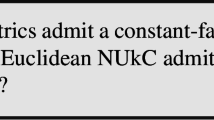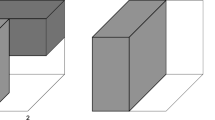Abstract
The problem of constructing metric ε-nets and corresponding coverings by balls for compact sets with a probability measure is considered. In the case of sets having metrically significant parts with a small measure (dark sets), methods for constructing ε-nets are combined with the deep holes method in a unified approach. According to this approach, a constructed metric net is supplemented with its deep hole (the most distant element of the set) until the required accuracy is achieved. An existing implementation of the method for a metric set with a given probability measure is based on a pure global search for deep holes. To construct dark coverings, the method is implemented on the basis of a random multistart. For the resulting nets, the logarithm of the number of their elements is shown to be close to ε-entropy, which means that they are optimal. Techniques for estimating the reliability and completeness of constructed (ε, δ)-coverings in the sense of C.E. Shannon are described. The methods under consideration can be used to construct coverings of implicitly given sets with a measure defined on the preimage and to recover compact supports of multidimensional random variables with an unknown distribution law.


Similar content being viewed by others
REFERENCES
V. A. Bushenkov, O. L. Chernykh, G. K. Kamenev, and A. V. Lotov, “Multidimensional images given by mappings: Construction and visualization,” Pattern Recogn. Image Anal. 5 (1), 35–56 (1995).
A. V. Lotov, V. A. Bushenkov, G. K. Kamenev, and O. L. Chernykh, Computer and Search for Balanced Tradeoff: The Feasible Goals Method (Nauka, Moscow, 1997) [in Russian].
A. V. Lotov, V. A. Bushenkov, and G. K. Kamenev, Interactive Decision Maps: Approximation and Visualization of Pareto Frontier (Kluwer Academic, Boston, 2004).
J. H. Conway and N. Sloane, Sphere Packings, Lattices, and Groups (Springer-Verlag, New York, 1988; Mir, Moscow, 1990), Vol. 1.
Yu. G. Evtushenko, “Numerical methods for finding global extrema of functions (case of a nonuniform mesh),” USSR Comput. Math. Math. Phys. 11 (6), 38–54 (1971).
Yu. G. Evtushenko and M. A. Posypkin, “Nonuniform covering method as applied to multicriteria optimization problems with guaranteed accuracy,” Comput. Math. Math. Phys. 53 (2), 144–157 (2013).
G. K. Kamenev and D. L. Kondrat’ev, “One research technique for nonclosed nonlinear models,” Mat. Model., No. 3, 105–118 (1992).
A. N. Kolmogorov and V. M. Tikhomirov, “ℰ-entropy and ℰ-capacity of sets in function spaces,” Usp. Mat. Nauk 14 (2), 3–86 (1959).
C. Shannon, “A mathematical theory of communication,” Bell Syst. Tech. 27 (3), 379–423 (1948); 27 (4), 623–656 (1948).
G. K. Kamenev, “Approximation of completely bounded sets by the deep holes method,” Comput. Math. Math. Phys. 41 (11), 1667–1675 (2001).
A. A. Zhigljavsky and A. G. Zilinskas, Search for Global Extremum (Nauka, Moscow, 1991) [in Russian].
G. K. Kamenev, “Method for approximating metric images with a small measure of the preimage,” Proceedings of the 9th All-Russia Scientific Conference on Mathematical Modeling of a Developing Economy, Ecology, and Technologies EKOMOD-2016, Kirov, 4–9 July, 2016 (2016), pp. 272–275.
G. K. Kamenev, “Study of convergence rate and efficiency of two-phase methods for approximating the Edgeworth–Pareto hull,” Comput. Math. Math. Phys. 53 (4), 375–385 (2013).
G. K. Kamenev, “Construction of dark coverings and phantom meshes,” International Conference on Numerical Geometry, Mesh Generation, and High-Performance Computations (NUMGRID2016). doi 10.13140/RG.2.2.32217.11360
A. N. Shiryaev, Probability (Nauka, Moscow, 1980) [in Russian].
ACKNOWLEDGMENTS
This work was supported by the Russian Foundation for Basic Research, project no. 18-01-00465a.
Author information
Authors and Affiliations
Corresponding author
Additional information
Translated by I. Ruzanova
Rights and permissions
About this article
Cite this article
Kamenev, G.K. Method for Constructing Optimal Dark Coverings. Comput. Math. and Math. Phys. 58, 1040–1048 (2018). https://doi.org/10.1134/S0965542518070084
Received:
Published:
Issue Date:
DOI: https://doi.org/10.1134/S0965542518070084




